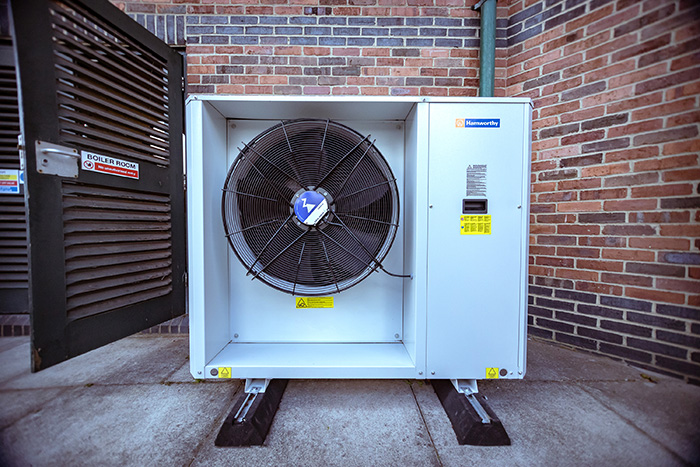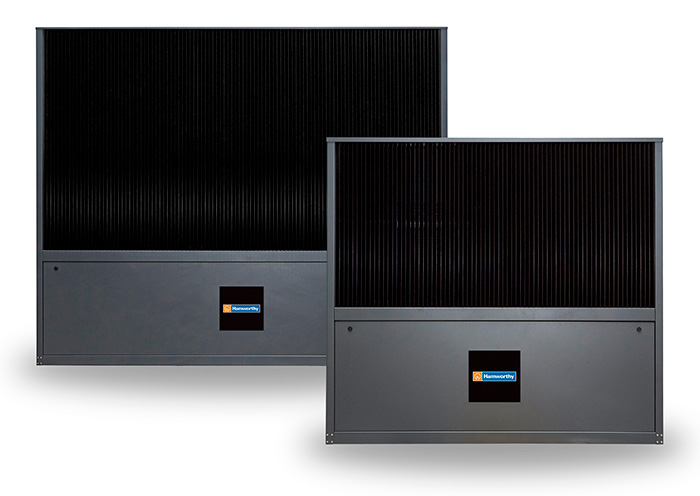What To Consider When Choosing A Heat Pump?

By Jason Allen, Commercial Product Manager, Groupe Atlantic UK, ROI & NA.
In line with the Government’s drive to decarbonise the UK, heat pumps play a valuable contribution to the delivery of a low‑carbon future, but at the heart of an efficient heat pump system lies an important element: the refrigerant. In this article, we look at synthetic and natural options and discuss the factors to consider when choosing the heat pump with the right refrigerant.
The Role Of Refrigerants In Air Source Heat Pumps
Essentially, refrigerants are the working liquids used in the process of the refrigeration cycle but first, let’s look at how this works in terms of a typical heat pump system. Heat pumps gather heat energy from the surrounding air, which, via a heat exchanger, is transferred into the heat pump refrigerant and turned into vapour. This vapour is then passed through a compressor and tuned into a high‑pressure, high‑temperature refrigerant, raising the temperature to a point that can deliver heat throughout a building’s heating system, via a Plate Heat Exchanger. Essentially, refrigerants are the lifeblood of heat pumps.
Different Refrigerant Types
With traditional refrigerants such as CFCs (halocarbons) and HCFCs (hydro halocarbons) now phased out due to their high Ozone Depletion and Global Warming Potential (GWP), refrigerant types are now broadly split into two categories: HFCs such as R32 and natural refrigerants, which include R290 and CO₂.
Factors to consider when choosing the right refrigerant for your heat pump:
Flow Temperature Of The Heat Pump

Manager, Groupe Atlantic UK, ROI & NA
Another common misconception is that heat pumps using synthetic refrigerants such as R32 cannot reach high enough temperatures. The reality is, many conventional R32 air source heat pumps on the market can reach up to 60°C and when controlled correctly for the type and construction of a building, they can efficiently keep a building warm all year round. In comparison, natural refrigerants such as R290 and CO₂. can produce very high temperatures of up to 75°C. However, assuming the heat pump is calibrated correctly, this temperature will not need to be reached in most cases but there are some instances where it might be appropriate.
For installation projects such as process heating (where specific temperatures are required for manufacturing or cleaning), large heating systems, such as district heating and shopping centres, and settings where a large volume of domestic hot water is needed, such as healthcare and leisure settings, where there are increased controls for risks such as Legionella, it may be more appropriate to use a high‑temperature heat pump with a natural refrigerant.
In terms of generating domestic hot water (DHW), a heat pump using R32 would be perfectly adequate, but it would need to be supplemented by another means of heating, to raise the temperature to 62C and prevent harmful Legionella bacteria growth from forming. This could be achieved with another heat source, such as a boiler, or by the use of immersion heaters but this can come with higher installation, running and capital costs. In this type of setting, a heat pump using natural refrigerant could reach the desired heat without additional backup and have a high COP at useable temperatures from 60C upwards.
Temperature Differential (Delta T)
The temperature differential (Delta T) of a heat pump system is another factor that should be considered as this can help to achieve an efficient heat delivery system. An efficient system should return water that is significantly colder than when it left the heat pump. The benefits of which are: smaller pipes needed for the same kWh of heat delivered, lower pumping cost because the volume of water is lower and decreased heat loss from the return pipe. Although possible to achieve heat pump designs based on 5 or 10C Delta Ts with refrigerants, such as R32 and R290, heat pumps using CO₂ can perform equally as well with a much higher Delta Ts for instance, CO₂ is actually at its most efficient at a temperature differential of 30 or 40°C.
Concerns Over Global Warming Potential (GWP)
When we talk about the Global Warming Potential (GWP) of a refrigerant, we’re referring to the measure of how much heat a greenhouse gas traps in the atmosphere over a specific period (usually 100 years), compared to carbon dioxide (CO₂). Simply put, the higher the GWP value, the higher the global warming potential, so the ultimate goal is to use refrigerants with lower GWP to mitigate climate change. This is where natural refrigerants take the spotlight.
Based on substances that already exist in the natural environment, natural refrigerants generally have a low impact on the environment with close to zero levels of ozone depletion and global warming potential. That being said, the quantities of HFC refrigerant used in today’s heat pumps is typically small, with modern heat pump design offering low risk when it comes to leakage. Regardless, it is an important consideration for end users who need to report losses in their carbon footprint assessments.
Coefficient Of Performance (COP) &
Seasonal Coefficient Of Performance (SCOP)

Understanding COP and SCOP are two important factors that also need to be considered. Providing a measure of a system’s performance, they enable environmental factors to be balanced against any practical considerations that need to be accounted for.
When we refer to COP, we’re referring to the ratio of heating capacity and total power input for example, a COP of 3 would mean, you generate 3 kW of heating capacity by using 1kW of electric power (assuming the heat pump is electric). In this situation, an optimally performing natural refrigerant such as CO₂, which features excellent heat transfer properties, could help enhance the overall efficiency of the heat pump. This is because it has a higher boiling point than traditional refrigerants, which allows less powerful heat pumps to be used, resulting in reduced overall energy consumption.
However, it is important to note that external temperatures can also have an impact on COP, so we also need to look at the SCOP (otherwise known as the Seasonal Performance Factor). This is the ratio of the total amount of heat delivered, divided by the total amount of energy consumed over the same period. This measure considers the temperature variations and provides a more realistic measure of a heat pump's annual energy efficiency. Here, CO₂ heat pumps offer the benefit of being able to operate at extremely low ambient temperatures because they have higher pressure compared to other more traditional refrigerants.
Toxicity And Flammability
Although there are very few refrigerants left in the marketplace with high levels of toxicity, there have been some concerns raised regarding the risks of explosion and fire. As you would expect, CO₂ refrigerant is a non‑flammable option, closely followed by R32, which is a low‑flammability refrigerant with a max burning velocity of <10cm/s. This essentially means that it is not an explosive liquid and the possibility of fire spreading, even if it did ignite, would be incredibly low with a very slow flame propagation speed. When it comes to R290, yes, it’s flammability risk is slighter higher but it’s important to keep things in perspective. Like many of us who have a propane‑fuelled BBQ sitting in our back gardens, without giving it a second thought, a rooftop heat pump with R290 refrigerant would propose minimal risk when used in the right conditions.
Cost Implications
Taking everything into account, when it comes to selecting a refrigerant for a heat pump, cost will undoubtedly play a large deciding factor. Whilst it could be argued that natural refrigerants such as CO₂ and R290 are naturally available, due to their up‑and‑coming popularity, CO₂ is currently experiencing a rapid price increase. In comparison, synthetic refrigerants such as R32 are still relatively cost‑effective and can be easily recycled.
Going Forward: The Future Of Refrigerants
Whilst R32 continues to offer a low cost, efficient and sustainable solution, natural refrigerants are, without a doubt, fast gaining popularity thanks to their higher output temperatures and lower GWP and ODP potential. However, with a no one size fits all solution, it is important to balance the above factors against the requirements of each specific project. and it is clear to see why many manufacturers and end users are looking towards heat pumps featuring natural refrigerants that help to future‑proof their investments.
Click the article to enlarge it.


























































